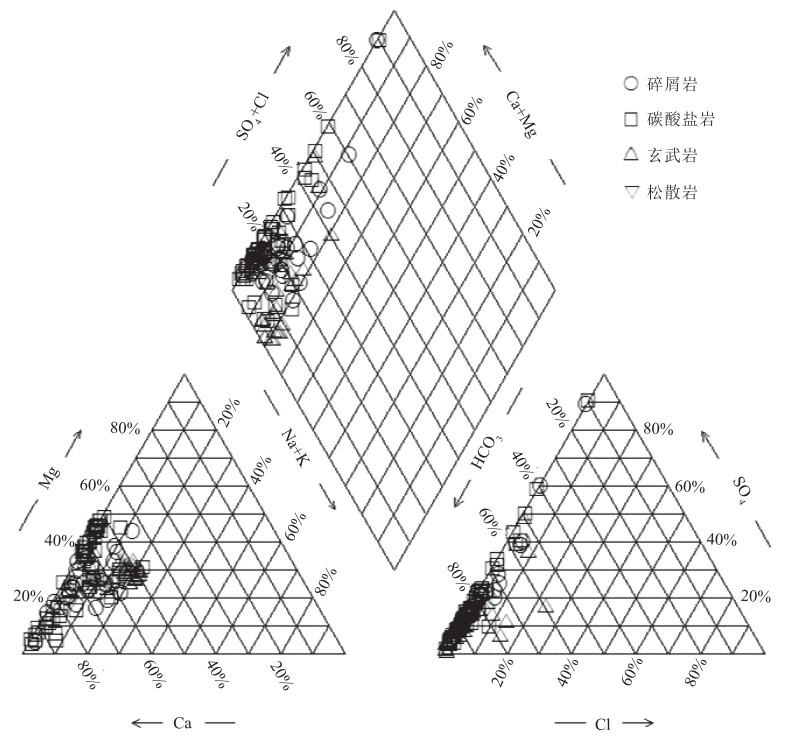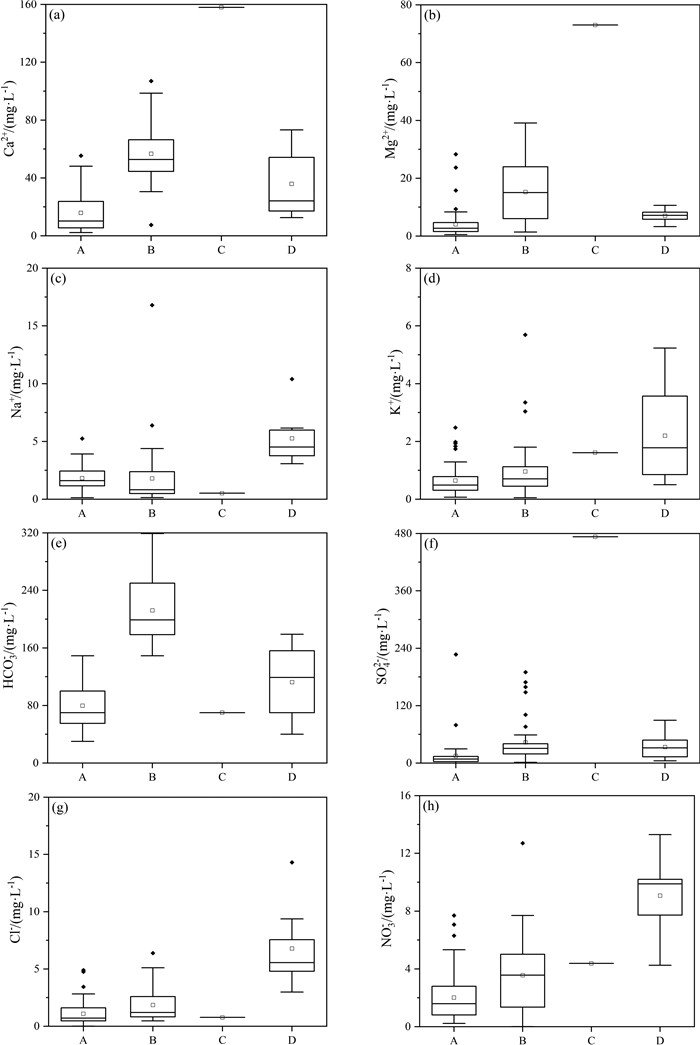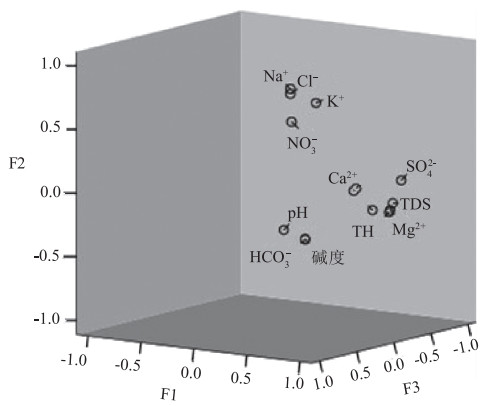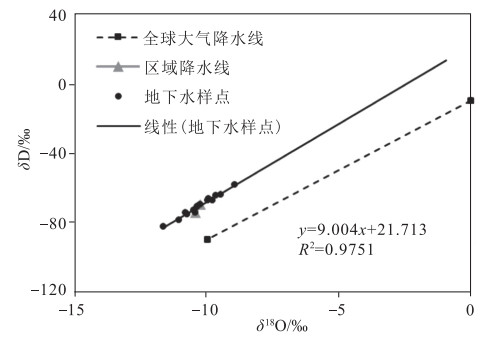Hydrochemical and isotopic characteristics of groundwater in Panhe area of Wumeng Mountain, Yunnan
-
摘要:
在乌蒙山1:5万五寨幅水文地质调查的基础上, 采集地下水样品, 结合地下水水化学组分聚类分析和因子分析方法, 研究区域地下水化学特征, 讨论其与水质评价结果的关系。结果表明, 研究区地下水化学类型以HCO3-Ca型水为主, 水化学组分具有明显的空间变异性。控制研究区地下水水化学组分的主要因素依次为水岩作用时间、含水层介质类型和人类活动。同位素测试结果印证了浅表地下水循环快、蒸发量较少, 地下水的盐分来源以矿物的溶解和溶滤为主。盘河区域地下水水质较好, 尤以玄武岩浅表风化裂隙富水结构中的A型水水质最优, 适合作为该缺水区的开发利用水源。B型水多为沉积岩区典型的溶滤水。C型水为V类水, 超标指标主要为SO42-, 源于原生矿物溶解和废弃煤矿矿井涌水。D型水多经过中深部循环。通过聚类分析法识别地下水的形成演化过程, 对在研究区开展供水井选址、发现矿泉水资源和水质评价有指导意义。
Abstract:This paper aimed at studying hydrochemical chemical characteristics in Wumeng Mountain1 50000 Wuzhai sheet.On the basis of hydrogeological survey in the study area, groundwater samples were collected, and the cluster analysis and factor analysis were used to discuss the relationship between the result and groundwater quality assessment.The results show that the main chemical type of groundwater in the study area is HCO3-Ca type, and the hydrochemical components have obvious spatial variability. The main factors controlling thehydrochemical composition of groundwater in the study area are water rock interaction time, aquifer medium type and human activities.The isotopic test results confirm that the circulation of shallow groundwater is fast and the evaporation is less, and the salt source of groundwater is mainly dissolution and leaching of minerals.The groundwater quality in Panhe area is good, especially the type A water in the water rich structure of shallow weathering fissures of basalt is the best, which is suitable for the development and utilization.Type B water is mostly typical solution filtered water in sedimentary rock area.Type C water is class V water, and the over standard index is mainly SO42-, which comes from the dissolution of primary minerals and the water inflow of abandoned coal mines.Most of the D-type water passes through the middle and deep circulation.The cluster analysis method can identify the formation and evolution process of groundwater, which has guiding significance for water supply well site selection, discovery of mineral water resources and water quality evaluation in the study area.
-

-
表 1 研究区地下水常规水化学参数统计结果
Table 1. Statistical results of chemical parameters of groundwater in the study area
变量 最大值 最小值 平均值 标准差 变异系数/% Ca2+ 158.00 2.25 34.59 27.75 80.25 Mg2+ 73.00 0.52 9.25 10.81 116.84 Na+ 16.80 0.13 2.07 2.12 102.61 K+ 5.69 0.05 0.90 0.93 103.79 HCO3- 319.00 30.00 133.81 74.30 55.53 SO42- 473.00 0.02 31.32 56.37 179.98 Cl- 14.30 0.01 1.83 2.10 114.95 TDS 868.00 9.00 187.33 111.04 59.28 pH 7.46 7.05 7.25 0.09 1.24 TH 690.00 8.00 123.73 103.49 83.64 碱度 262.00 24.00 109.71 61.00 55.61 NO3- 13.30 0.004 3.20 2.80 87.62 注:除pH值为无量纲外,其余变量的单位为mg/L 表 2 聚类分类的水质统计
Table 2. Water quality evaluation of samples classified by cluster analysis
聚类分析类别 水质分类 Ⅰ类 Ⅱ类 Ⅲ类 Ⅴ类 A型地下水 25 27 7 0 B型地下水 1 28 15 0 C型地下水 0 0 0 1 D型地下水 0 1 8 0 表 3 研究区地下水水化学参数的旋转因子载荷矩阵
Table 3. Matrix of rotated factor loadings of chemical parameters in the study area
变量 F1 F2 F3 Ca2+ 0.942* -0.081 0.046 Mg2+ 0.826* -0.151 -0.355 Na+ 0.048 0.758* -0.121 K+ 0.359 0.693* -0.022 HCO3- 0.709* -0.249 0.625* SO42- 0.719* 0.03 -0.659 Cl- 0.301 0.796* 0.24 TDS 0.96* -0.059 -0.2 pH 0.045 -0.338 -0.038 TH 0.98* -0.118 -0.12 碱度 0.709* -0.248 0.625* NO3- 0.333 0.585* 0.27 注:*表示较高的因子载荷 表 4 氢氧同位素测试结果
Table 4. Hydrogen and oxygen isotope results
样品 样品类别 δDV-SMOW/‰ δ18OV-SMOW/‰ 3H/TU WB003 地下水 -58.5 -8.95 5.27 WC086 地下水 -79.2 -11.08 3.19 WC080 地下水 -82.7 -11.68 3.01 WB080 地下水 -73.5 -10.53 3.68 WB070 地下水 -67.9 -9.98 5.70 WA075 地下水 -75.6 -10.78 2.35 WA067 地下水 -64.5 -9.48 3.80 WA068 地下水 -66.9 -9.95 4.36 WB027 地表水
(暗河入口)-70.9 -10.35 5.66 WC032 地下水 -71.6 -10.39 3.13 WB072 地下水 -67.5 -9.80 2.67 WD041 地下水 -69.9 -10.28 4.96 WA003 地下水 -64.7 -9.68 4.00 WB011 地下水 -74.7 -10.83 4.28 WC049 雨水 -74.7 -10.45 3.37 -
[1] 洪涛, 谢运球, 喻崎雯, 等. 乌蒙山重点地区地下水水化学特征及成因分析[J]. 地球与环境, 2016, 44(1): 11-18. https://www.cnki.com.cn/Article/CJFDTOTAL-DZDQ201601002.htm
[2] 鲁孟胜, 韩宝平, 武凡, 等. 鲁西南地区高氟地下水特征及成因探讨[J]. 中国地质, 2014, 41(1): 294-302. doi: 10.3969/j.issn.1000-3657.2014.01.024
[3] 柳凤霞, 史紫薇, 钱会, 等. 银川地区地下水水化学特征演化规律及水质评价[J]. 环境化学, 2019, 38(9): 2055-2066. https://www.cnki.com.cn/Article/CJFDTOTAL-HJHX201909013.htm
[4] 王焰新, 高旭波. 人类活动影响下娘子关岩溶水系统地球化学演化[J]. 中国岩溶, 2009, 28(2): 103 -112. https://www.cnki.com.cn/Article/CJFDTOTAL-ZGYR200902007.htm
[5] Cloutier V, Lefebvre R, Therrien R, et al. Multivariatestatisticalanalysis of geochemical data as indicative of the hydrogeochemical evolution of groundwater in a sedimentary rock aquifer system[J]. Journal of Hydrology, 2008, 353(3): 294-313. https://www.sciencedirect.com/science/article/pii/S0022169408001005
[6] 董维红, 苏小四, 侯光才, 等. 鄂尔多斯白垩系地下水盆地地下水水化学类型的分布规律[J]. 吉林大学学报(地球科学版), 2007, 37(2): 288-292. https://www.cnki.com.cn/Article/CJFDTOTAL-CCDZ200702014.htm
[7] 沈照理, 王焰新. 水-岩相互作用研究的回顾与展望[J]. 地球科学: 中国地质大学学报, 2002, 27(2): 127-133. https://www.cnki.com.cn/Article/CJFDTOTAL-DQKX200202002.htm
[8] 袁建飞, 邓国仕, 徐芬, 等. 毕节市北部岩溶地下水水文地球化学特征[J]. 水文地质工程地质, 2016, 43(1): 12-21. https://www.cnki.com.cn/Article/CJFDTOTAL-SWDG201601004.htm
[9] 蒋勇军, 吴月霞, Groves C, 等. 利用因子分析确定岩溶地下河系统水质的影响因素[J]. 水文地质工程地质, 2009, (4): 1-7. https://www.cnki.com.cn/Article/CJFDTOTAL-SWDG200904003.htm
[10] 蒲文斌, 钱康, 陈鹏, 等. 乌蒙山1:5万奎香幅地下水水质评价及相关性分析[J]. 地下水, 2020, 42(2): 7-10. https://www.cnki.com.cn/Article/CJFDTOTAL-DXSU202002003.htm
[11] Lambrakis N, Antonakos A, Panagopoulos G. The use of multicomponent statistical analysis in hydrogeological environmental research[J]. Water Research, 2004, 38(7): 1862-1872. https://www.sciencedirect.com/science/article/pii/S0043135404000260
[12] Helstrup T, Jrgensen N O, Banoeng-Yakubo B. Investigation of hydrochemical characteristics of groundwater from the Cretaceous-Eocene limestone aquifer in southern Ghana and southern Togo using hierarchical cluster analysis[J]. Hydrogeology Journal, 2007, 15(5): 977-989. https://link.springer.com/article/10.1007/s10040-007-0165-1
[13] 袁建飞, 邓国仕, 徐芬. 毕节市北部岩溶地下水水化学特征及影响因素的多元统计分析[J]. 中国地质, 2016, 43(4): 1446-1456. https://www.cnki.com.cn/Article/CJFDTOTAL-DIZI201604029.htm
[14] Mouser P J, Rizzo D M, Röling W F M, et al. A multivariate statistical approach to spatial representation of groundwater contamination using hydrochemistry and microbial community profiles[J]. Environmental Science & Technology, 2005, 39(19): 7551-7559. https://dialnet.unirioja.es/servlet/articulo?codigo=1317234
[15] Liu Chenwuing, Lin Kaohung, Kuo Yiming. Application of factor analysis in the assessment of groundwater quality in a blackfoot disease area in Taiwan[J]. Science of the Total Environment, 2003, 313(1): 77-89. https://www.sciencedirect.com/science/article/pii/S0048969702006836
[16] Olmez I, Beal J W, J Villaume F. A new approach to understanding multiple- source groundwater contamination: Factor analysis and chemical mass balances[J]. Water Research, 1994, 28(5): 1095-1101. https://www.sciencedirect.com/science/article/pii/0043135494901953
[17] 程东会, 钱康, 常琛朝. 水分入渗条件下层状非饱和松散沉积物中的毛细壁垒效应研究[J]. 水文地质工程地质, 2016, 43(4): 20-25. https://www.cnki.com.cn/Article/CJFDTOTAL-SWDG201604005.htm
[18] Omo-Irabor O O, Olobaniyi S B, Oduyemi K, et al. Surface and groundwater water quality assessment using multivariate analytical methods: A case study of the Western Niger Delta, Nigeria[J]. Physics and Chemistry of the Earth, Parts A/B/C, 2008, 33(8): 666-673. https://www.sciencedirect.com/science/article/pii/S1474706508001393
[19] Yadav I, Devi N, Mohan D, et al. Groundwater classification using multivariate statistical methods: Birimian Basin, Ghana[J]. Journal of Environmental Engineering, 2010, 136(12): 1379-1388. https://ascelibrary.org/doi/10.1061/%28ASCE%29EE.1943-7870.0000291
[20] 沈杨, 何江涛, 王俊杰, 等. 基于多元统计方法的地下水水化学特征分析: 以沈阳市李官堡傍河水源地为例[J]. 现代地质, 2013, 27(2): 440-447. https://www.cnki.com.cn/Article/CJFDTOTAL-XDDZ201302024.htm
[21] 郝春明, 何培雍, 王议, 等. 煤炭开采后峰峰矿区奥陶系岩溶水硫酸盐演化过程研究[J]. 中国岩溶, 2014, 33(4): 425-431. https://www.cnki.com.cn/Article/CJFDTOTAL-ZGYR201404007.htm
[22] 潘晓东, 梁杏, 唐建生, 等. 黔东北高原斜坡地区4种岩溶地下水系统模式及特点——基于地貌和蓄水构造特征[J]. 地球学报, 2015, 36(1): 85-93. https://www.cnki.com.cn/Article/CJFDTOTAL-DQXB201501012.htm
-




 下载:
下载:




